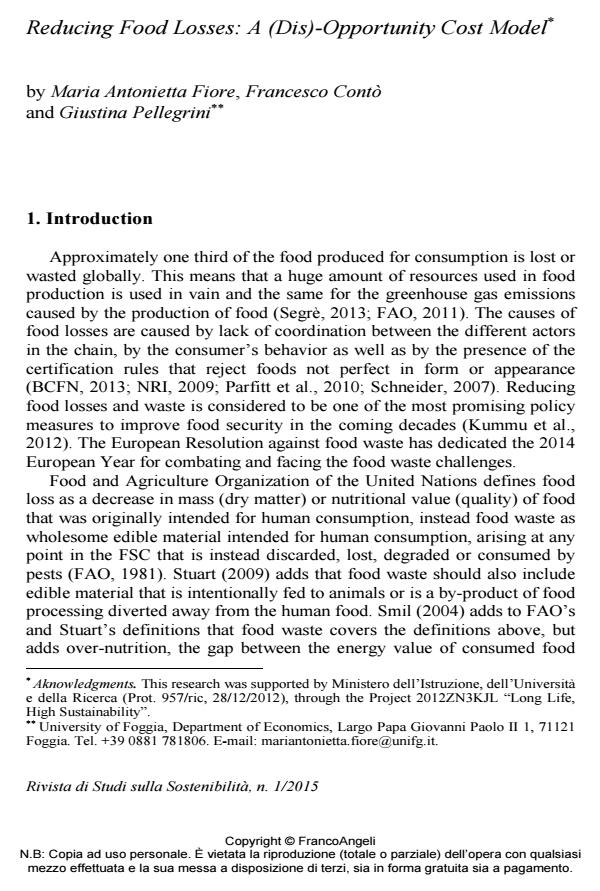Reducing Food Losses: A (Dis)-Opportunity Cost Model
Journal title RIVISTA DI STUDI SULLA SOSTENIBILITA'
Author/s Mariantonietta Fiore, Francesco Contò, Giustina Pellegrini
Publishing Year 2015 Issue 2015/1
Language English Pages 16 P. 151-166 File size 242 KB
DOI 10.3280/RISS2015-001010
DOI is like a bar code for intellectual property: to have more infomation
click here
Below, you can see the article first page
If you want to buy this article in PDF format, you can do it, following the instructions to buy download credits

FrancoAngeli is member of Publishers International Linking Association, Inc (PILA), a not-for-profit association which run the CrossRef service enabling links to and from online scholarly content.
A huge amount of resources used in food production is lost or wasted globally and the same for the greenhouse gas emissions caused by the production of food. A plethora of methodologies to assess economic, environmental and social impacts stands out. The aim of this paper is to analyze the social impacts of food losses along the food chain: the methodology is based on the elaboration of a disopportunity cost taking into account food waste and losses Kcals and Kcals/required per day (to cope with the energy expenditure), U.A.A. (Utilized Agricultural Area) cost. Findings are aimed at highlighting how the food looses reduction is crucial for an intra-generational equity.
Keywords: Food loss, food waste, economic-social impact, (dis)-opportunity cost, sustainability, intra-generational equity.
- Grape residue flour as an antioxidant and fiber source in beef meatballs Larissa Christine Tuffi, Daniel Angelo Longhi, Jéssica Carvalho Hernandes, Paulo Cézar Gregório, Carlos Eduardo Rocha Garcia, in British Food Journal /2021 pp.2831
DOI: 10.1108/BFJ-12-2020-1152 - Hidden flows assessment in the agri-food sector: evidence from the Italian beef system Vera Amicarelli, Mariantonietta Fiore, Christian Bux, in British Food Journal /2021 pp.384
DOI: 10.1108/BFJ-05-2021-0547 - A Worldwide Hotspot Analysis on Food Loss and Waste, Associated Greenhouse Gas Emissions, and Protein Losses Xuezhen Guo, Jan Broeze, Jim J. Groot, Heike Axmann, Martijntje Vollebregt, in Sustainability /2020 pp.7488
DOI: 10.3390/su12187488 - Green metamorphoses: agriculture, food, ecology M. Fiore, G. Pellegrini, F. Conto, pp.225 (DOI:10.3920/978-90-8686-898-8_18)
- Food Loss and Waste, a global responsibility?! Nino Adamashvili, Filomena Chiara, Mariantonietta Fiore, in ECONOMIA AGRO-ALIMENTARE 3/2020 pp.825
DOI: 10.3280/ECAG2019-003014 - The Role of Communication Tools in the Knowledge and Diffusion of Sustainable Development Goals: Insights from Multiple Correspondence Analysis Maria Rosaria Maschio, Alessia Spada, Mariantonietta Fiore, in Sustainability /2024 pp.10868
DOI: 10.3390/su162410868
Mariantonietta Fiore, Francesco Contò, Giustina Pellegrini, Reducing Food Losses: A (Dis)-Opportunity Cost Model in "RIVISTA DI STUDI SULLA SOSTENIBILITA'" 1/2015, pp 151-166, DOI: 10.3280/RISS2015-001010